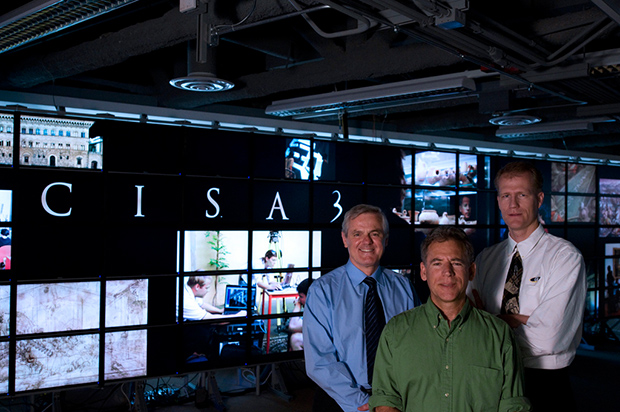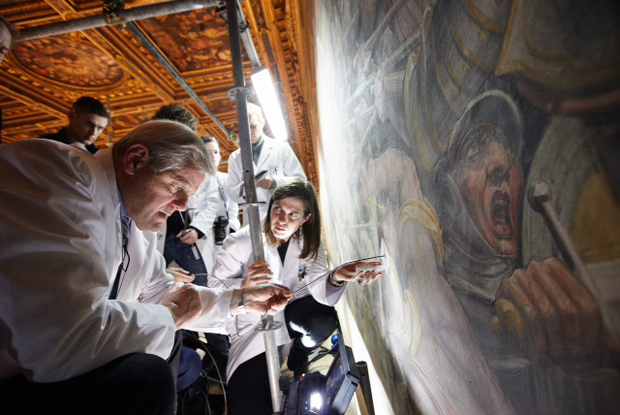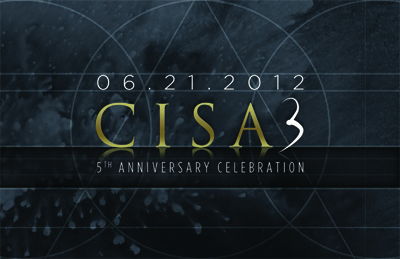
Culture Heritage Center at UC San Diego Celebrates 5th Anniversary
By:
- Doug Ramsey
Published Date
By:
- Doug Ramsey
Share This:
Article Content

CISA3 leadership (l-r) founding director Maurizio Seracini, associate director Tom Levy, and new director Falko Kuester.
Five years on, a research center at the University of California, San Diego focused on technology and cultural heritage has become an important player in efforts to study, safeguard and preserve historic buildings, works of art as well as archaeological sites and artifacts.
The Center of Interdisciplinary Science for Art, Architecture and Archaeology (CISA3) will celebrate its 5th Anniversary on Thursday, June 21with a series of free public lectures, documentaries, lab tours, networking sessions and roundtable discussions about future research initiatives.
CISA3 is based in the California Institute for Telecommunications and Information Technology (Calit2) and is a partnership of Calit2, the Jacobs School of Engineering, and UCSD’s Division of Arts & Humanities.

CISA3 researcher and National Geographic Fellow Maurizio Seracini and CISA3 assistant director Alexandra Hubenko look behind a wall in Florence's Palazzo Vecchio for possible evidence of a lost Leonardo da Vinci mural. (Photo by Dave Yoder for National Geographic).
The anniversary coincides with a shuffle of responsibilities among CISA3 leaders. Founding director and UC San Diego alumnus Maurizio Seracini (Class of ’73, Bioengineering) will remain actively involved in CISA3 research, but has been asked by the campus to take on a leadership role in launching a UCSD-Italian research collaboration focused on engineering and medicine. Taking his place as director of CISA3 is computer science and structural engineering professor Falko Kuester, who has been an associate director of the center since its inception.
Kuester is also the principal investigator on a $3.2 million, five-year Integrative Graduate Education and Research Traineeship (IGERT) grant from the National Science Foundation (NSF) focused on training, research and education in engineering for cultural heritage diagnostics (TEECH). NSF awarded the grant in August 2010, with a large portion of the funding to support UCSD graduate students working on interdisciplinary projects in this emerging field.
“The IGERT TEECH project has become a critical vehicle for funding CISA3 research because most of its funding goes to support graduate students at UCSD and on field expeditions abroad,” said Kuester. “Most of the other costs have been borne by Calit2 or private donors through the Jacobs School, so philanthropy remains critical to the center’s success.”
More than $1 million has beent donated by roughly 50 individuals and philanthropic foundations over the past five years, and that figure tops $1.4 million when in-kind gifts are included. Donor funds are primarily used to support the center’s research and field projects in Italy, Jordan and Mongolia, including several projects in partnership with the National Geographic Society. Major donors and supporters of CISA3 have included Paul and Stacy Jacobs, Robert and Natalie Englekirk, Kevin and Tamara Kinsella, Rick Sandstrom and Sandra Timmons, Linda Brandes, Doug Carlson, Steve and Sue Hart, Ken Widder and Jacki Johnson, among others. For a full list of donors, visithttp://culturalheritage.calit2.net/cisa3/patrons.php
Seracini, a National Geographic Fellow, will continue to play an active and integral role in CISA3 as the leader of its current and future projects in Italy, including the high-profile search for Leonardo da Vinci’s lost mural, ‘The Battle of Anghiari’. Efforts in late 2011 to undertake an endoscopic survey in the Hall of the 500 in Florence’s Palazzo Vecchio turned up intriguing new clues to the likely location where the Leonardo mural may have been hidden behind a new wall erected 450 years to safeguard the da Vinci masterpiece, but the findings fell short of conclusive evidence that the mural is still there. CISA3 has also begun a long-term project to document and analyze Florence’s 600-year-old Palazzo Medici, widely considered to be the birthplace of the Renaissance. Seracini also has access to works in the permanent collection of the Uffizi Gallery, including da Vinci’s “The Annunciation”.

CISA3 will mark its fifth anniversary on June 21 with an open house, lab tours, documentary screenings, talks, and a roundtable on the future of cyber-archaeology. The day's events are free of charge and open to the public; RSVP no later than Tuesday, June 19. Click on image above to register.
The public is invited to visit Atkinson Hall on the UC San Diego campus from 1-8pm on Thursday, June 21. From 1-5pm, there will be screenings of three National Geographic documentaries profiling the projects of CISA3:
- The Forbidden Tomb of Genghis Khan, with Calit2 research scientist Albert Yu-Min Lin, which first aired on November 9, 2011
- Quest for Solomon’s Mines, with CISA3 associate director Tom Levy, a co-production of National Geographic and PBS’s NOVA, which premiered on PBS in late November 2010
- Finding the Lost Da Vinci, with Maurizio Seracini, which has been airing around the world on National Geographic channels since its initial U.S. broadcast on March 20, 2012.
Levy and Lin will be on hand to introduce their documentaries and respond to audience questions, while Seracini will do the same via live, high-definition videoconferencing from Florence.
From 2-6pm CISA3 labs will be open to the public for demonstrations of technologies and research findings made by faculty, staff scientists and graduate students who are part of CISA3 and the IGERT TEECH project. Many of the students spent part of last summer in Italy, Jordan or Mongolia.
A reception from 5-6:30pm will be followed by a session, “The Future Is Now: Art, Science and Cultural Heritage.” Director Falko Kuester will introduce a panel of CISA3 researchers who will talk about projects in cultural heritage and conservation that they hope to undertake in the next two years, many of which are centered on cyber-archaeology, art conservation and global exploration. Visitors will have an opportunity to talk one-on-one with the researchers over coffee and dessert at 7:30pm.
The 5th Anniversary events are open to the public and free of charge, but interested visitors are asked to RSVP no later than Monday, June 18 at http://bit.ly/JVJTyq.
For more information about ways to support CISA3 and the World Cultural Heritage Society, please contact Sarah Beckman, Director of Development, at sbeckman@ucsd.edu or call (858) 534-7320. To contribute via the Web, go to http://culturalheritage.calit2.net/cisa3/patrons.php and click on “Give Now” to be directed to the UC San Diego Giving site.
Share This:
You May Also Like
Stay in the Know
Keep up with all the latest from UC San Diego. Subscribe to the newsletter today.


